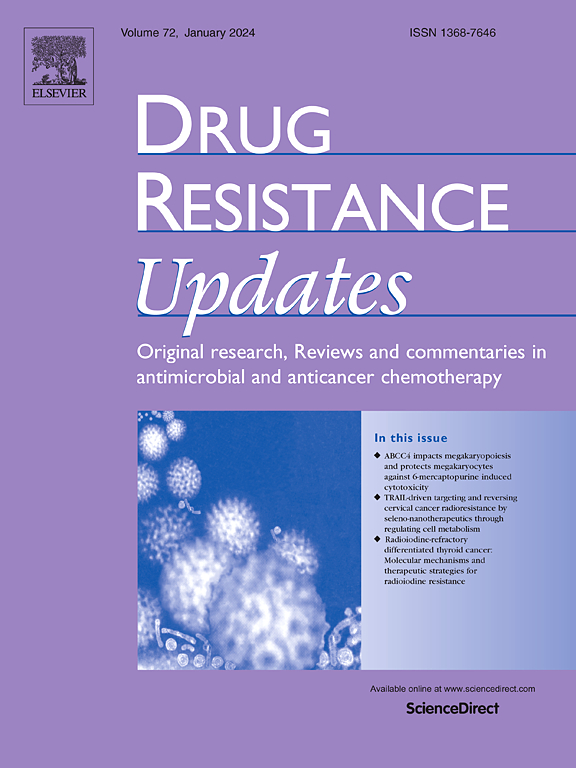Gamma-synuclein drives bevacizumab resistance in colorectal cancer via VEGFR2 activation and angiogenesis
IF 21.7
1区 医学
Q1 PHARMACOLOGY & PHARMACY
引用次数: 0
Abstract
Background
Resistance to Bevacizumab (Bev) remains a major obstacle in colorectal cancer (CRC) treatment. Gamma-synuclein (SNCG), overexpressed in tumor vasculature and cancer cells, is investigated here for its role in Bev resistance and therapeutic potential.
Methods
Using isogenic CRC models with SNCG overexpression or knockout, we assessed SNCG's impact on Bev response in vitro and in vivo. The therapeutic efficacy of combining Bev with an anti-SNCG monoclonal antibody (42#) was evaluated in Bev-resistant models. Mechanistic studies, including ELISA, Western blot, surface plasmon resonance (SPR), and molecular docking, explored interactions between SNCG, VEGF, and VEGFR2.
Results
SNCG overexpression reduced Bev sensitivity by impairing the inhibition of migration, invasion, and spheroid formation, whereas SNCG knockout enhanced therapeutic response. Molecular docking revealed that SNCG binds VEGFR2 at an allosteric site, forming a stable ternary complex (SNCG-VEGF-VEGFR2) with enhanced hydrogen bonding, which sustained VEGFR2 phosphorylation and angiogenesis. In vivo, SNCG-overexpressing tumors showed reduced responsiveness to Bev (42.8 % inhibition vs. 64.3 % in controls, p < 0.05), while SNCG-deficient tumors exhibited a 3.2-fold increase in sensitivity. Combining Bev with 42# synergistically suppressed tumor growth (0.70 ± 0.36 g vs. 1.55 ± 0.41 g, p = 0.003), reduced metastatic burden (0.29 ± 0.23 g vs. 0.97 ± 0.42 g, p = 0.006), and extended median survival (86.8 vs. 69.8 days, p = 0.033) in Bev-resistant models.
Conclusions
SNCG drives Bev resistance in CRC by forming a ternary complex with VEGF and VEGFR2, enhancing VEGFR2 signaling and angiogenesis. Dual targeting of VEGF and SNCG represents a promising therapeutic strategy to overcome Bev resistance, with the potential to improve outcomes in CRC patients.
γ -突触核蛋白通过VEGFR2激活和血管生成驱动结直肠癌的贝伐单抗耐药
贝伐单抗(Bevacizumab, Bev)耐药仍然是结直肠癌(CRC)治疗的主要障碍。在肿瘤血管和癌细胞中过度表达的γ -突触核蛋白(SNCG)在Bev耐药和治疗潜力中的作用进行了研究。方法采用SNCG过表达或敲除的等基因CRC模型,在体外和体内评估SNCG对Bev反应的影响。在Bev耐药模型中评估Bev联合抗sncg单克隆抗体(42#)的治疗效果。机制研究包括ELISA、Western blot、表面等离子体共振(SPR)和分子对接等,探讨了SNCG、VEGF和VEGFR2之间的相互作用。结果SNCG过表达降低了Bev的敏感性,损害了对迁移、侵袭和球体形成的抑制,而SNCG敲除增强了治疗反应。分子对接发现,SNCG在变构位点与VEGFR2结合,形成稳定的三元配合物(SNCG- vegf -VEGFR2),氢键增强,维持VEGFR2磷酸化和血管生成。在体内,sncg过表达的肿瘤对Bev的反应性降低(对照组抑制率为42.8 %,对照组为64.3 %,p <; 0.05),而sncg缺陷肿瘤的敏感性增加了3.2倍。贝福结合42 #协同抑制肿瘤生长( 0.70±0.36 g和1.55 ±0.41 g p = 0.003),降低转移负担( 0.29±0.23 g和0.97 ±0.42 g p = 0.006),和延长平均存活(86.8 vs 69.8天,p = 0.033)在Bev-resistant模型。结论sncg通过与VEGF和VEGFR2形成三元复合物,增强VEGFR2信号传导和血管生成,从而驱动结直肠癌的Bev耐药。VEGF和SNCG的双重靶向治疗是克服Bev耐药的一种有希望的治疗策略,有可能改善结直肠癌患者的预后。
本文章由计算机程序翻译,如有差异,请以英文原文为准。
求助全文
约1分钟内获得全文
求助全文
来源期刊

Drug Resistance Updates
医学-药学
CiteScore
26.20
自引率
11.90%
发文量
32
审稿时长
29 days
期刊介绍:
Drug Resistance Updates serves as a platform for publishing original research, commentary, and expert reviews on significant advancements in drug resistance related to infectious diseases and cancer. It encompasses diverse disciplines such as molecular biology, biochemistry, cell biology, pharmacology, microbiology, preclinical therapeutics, oncology, and clinical medicine. The journal addresses both basic research and clinical aspects of drug resistance, providing insights into novel drugs and strategies to overcome resistance. Original research articles are welcomed, and review articles are authored by leaders in the field by invitation.
Articles are written by leaders in the field, in response to an invitation from the Editors, and are peer-reviewed prior to publication. Articles are clear, readable, and up-to-date, suitable for a multidisciplinary readership and include schematic diagrams and other illustrations conveying the major points of the article. The goal is to highlight recent areas of growth and put them in perspective.
*Expert reviews in clinical and basic drug resistance research in oncology and infectious disease
*Describes emerging technologies and therapies, particularly those that overcome drug resistance
*Emphasises common themes in microbial and cancer research
 求助内容:
求助内容: 应助结果提醒方式:
应助结果提醒方式:


